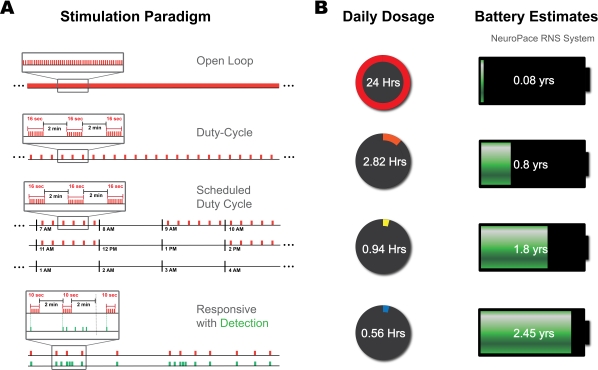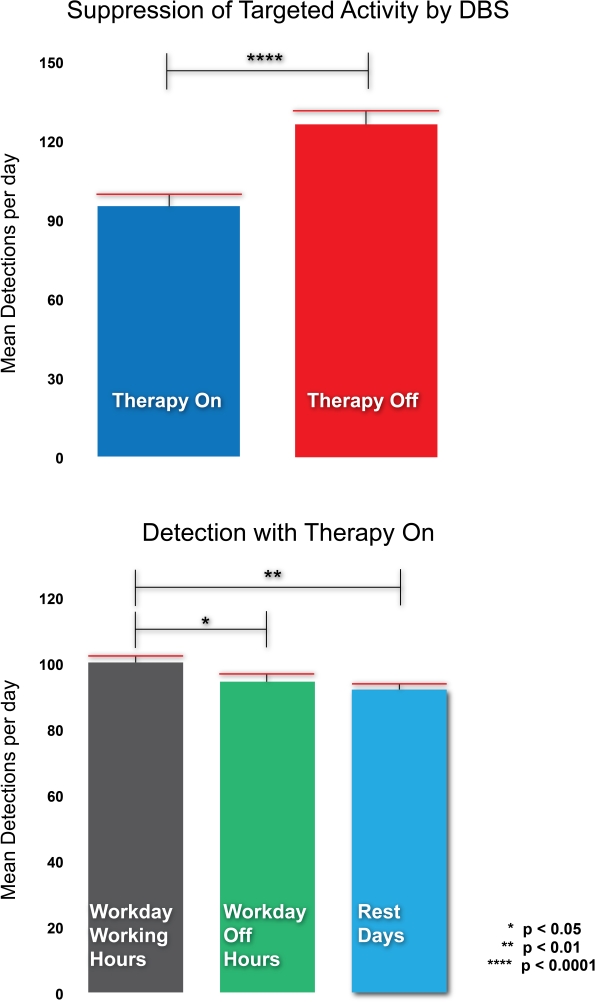Session Information
Date: Tuesday, June 21, 2016
Session Title: Hyperkinetic Movement Disorders, RLS, Sleep
Session Time: 12:30pm-2:00pm
Objective: To develop and measure the effectiveness of responsive deep brain stimulation for the treatment of Tourette syndrome.
Background: Tourette’s Syndrome (TS) is a paroxysmal movement disorder characterized by involuntary motor and vocal tics (1,2). Herein we present the case of TS patient who has been refractory to other treatment modalities and was therefore treated with deep brain stimulation (DBS).
Methods: The patient was implanted with bilateral Neuropace responsive neurostimulators (RNS) in the centromedian-parafascicular (Cm-Pf) complex of the thalamus. The patient was initially on a scheduled therapy delivery paradigm, and required device replacement an average of every 1.5 years. A responsive stimulation therapy was designed, where the patients own electrophysiology served as the control signal for stimulation delivery  . A low-frequency, 5-15Hz, detector yield the best correlation to tic activity and supported with patient feedback. Stimulation logs revealed a decrease of targeted activity under stimulation and a correlation between detection rates and patients reported stress level due to work, rest days, or other life changes
. A low-frequency, 5-15Hz, detector yield the best correlation to tic activity and supported with patient feedback. Stimulation logs revealed a decrease of targeted activity under stimulation and a correlation between detection rates and patients reported stress level due to work, rest days, or other life changes  . Therapy efficacy was measured over 6 monthly and 3 semi-annual visits with videotaped Modified Rush Tic Rating Scale (MRTRS).
. Therapy efficacy was measured over 6 monthly and 3 semi-annual visits with videotaped Modified Rush Tic Rating Scale (MRTRS).
Results: The last two visits where the patient was on the responsive paradigm were tested against the scheduled therapy and were found to not be statistically different. Upon modeling the service life of the devices, the responsive stimulation model projected an average life 3 times longer than the scheduled therapy.
Conclusions: As these devices must be surgically replaced at the end of their service and the patient will likely continue therapy for decades, this increase in battery life results in a 25% reduction in the number of surgeries. This patient is the first TS case in which DBS was delivered under a long term responsive paradigm. The device has gained a longer service life while delivering statistically equivalent therapy.
To cite this abstract in AMA style:
R.A. Molina, J.B. Shute, P.J. Rossi, E. Opri, K.D. Foote, M.S. Okun, A. Gunduz. Long-term responsive deep brain stimulation in Tourette syndrome [abstract]. Mov Disord. 2016; 31 (suppl 2). https://www.mdsabstracts.org/abstract/long-term-responsive-deep-brain-stimulation-in-tourette-syndrome/. Accessed April 4, 2025.« Back to 2016 International Congress
MDS Abstracts - https://www.mdsabstracts.org/abstract/long-term-responsive-deep-brain-stimulation-in-tourette-syndrome/
